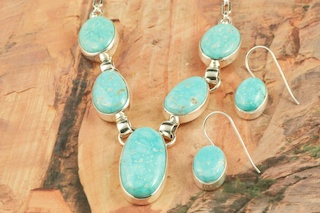Turquoise Jewelry
Turquoise is a sacred stone that has been used in jewelry for centuries.
For thousands of years, turquoise has been treasured both for its natural beauty as well as its presumed power to heal.
by Donna Bunnell • October 02, 2017

Turquoise is a sacred stone “that has been used for centuries to adorn ritual objects and is still considered a cherished possession by Native Americans and Mexican Indians,” says Carol Karasik, author of The Turquoise Trail. An anthropologist as well as a jeweler, Karasik has published several books on native art, crafts and culture.
Turquoise Jewelry
“Production of turquoise jewelry is a vibrant cottage industry in the Southwest,” she said, “where members of the Navajo, Hopi, Zuni, Pueblo and other nations…create [jewelry] which hark back to prehistoric myths and traditional clan symbols.”
For thousands of years, turquoise has been treasured both for its natural beauty as well as its presumed power to heal. Not only was turquoise used by North American Native Indians for jewelry and carvings, its history even dates back as early as to Ancient Egypt, as exquisite turquoise adornments have been uncovered in tombs.
The Color of Turquoise
The color of turquoise can span a pallet ranging from a greenish yellow to dramatic blue, and this semi-precious stone is mined across the globe. In addition to its attractive appearance and the relative ease with which it can be drilled for stringing on beads or be carved into the shapes of fetish animals, turquoise has a more mystic property.
Myths and Legends
According to the myths and legends of several cultures, the stone is believed to have the power to heal. In addition, it is reputed to assist in creativity, aid in making speeches and reduce stress. Furthermore, turquoise is said to have the ability to detoxify the body, give its wearer a deeper sense of self-knowledge, strengthen relationships, enhance friendships, and increase honesty and wisdom.
Types of Turquoise
Besides North America and Egypt, turquoise mines can be found in China, Iran and Turkey. The actual hue of the stone is determined by different minerals present in the surrounding earth. The presence of iron creates a more greenish turquoise, while copper in the area generates a stone that is more blue in appearance. If there is zinc in the adjacent soil, the gem will be greenish yellow. Finally, there is a rare variety found in an area of Nevada where no minerals are present that is known as White Buffalo turquoise.
Cleaning Turquoise Jewelry
Care should be taken by one who wishes to clean turquoise jewelry, especially if it is a valuable antique piece. Dousing stones in chemical solvents can cause serious damage to the porous structure.
These gemstones must never be cleaned using ultrasonic or steam cleaners. Instead, mix some warm water and soap, and use a cotton-tipped swab dipped in the solution to gently remove soil, after which the turquoise should be wiped with clear water to wash off any residual soap.
Whether it is an antique heirloom or a modern creation modeled on traditional styles, a piece of turquoise and silver jewelry, handmade by a Native American Indian craftsperson can be treasured both for its beauty as well as the ancient heritage it represents.
dna testing, dna ancestry testing, ancestry, genealogy, indian genealogy records, paternity testing, turquoise jewelry, native american jewelry
Native American Encyclopedia

